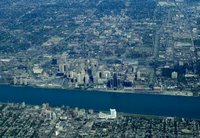Super Bowl As A Precursor To A Common Market

I am probably reading too much into things but the recently finished "international" Super Bowl could be an impetus for continental and not just regional co-operation.
One of the areas that I need to do some more reading on is on a “customs union” concept for Canada and the US similar to that of the European Community.
One of the ways to achieve a single market there:
One of the areas that I need to do some more reading on is on a “customs union” concept for Canada and the US similar to that of the European Community.
One of the ways to achieve a single market there:
- “was to open up the borders, allowing people, goods and services to move around freely within the EEC…
in 1985, the Commission – under President Jacques Delors – published a startling White Paper. It pointed out that the expanding Community had the potential to become a single market serving more than 300 million consumers. But it also showed very clearly that this tremendous potential was being thwarted by many obstacles: queues at border crossings; technical barriers to trade; closed markets for public contracts… The cost of this inefficiency – the ‘cost of non-Europe’ as it was famously called – was put at around 200 billion euro.
The White Paper spurred the 12 member states into action. In February 1986, they signed the Single European Act, setting out a timetable for taking the 270 or so steps necessary for completing the single market by 1993. Progress thereafter was rapid. Businesses, professions and trade unions all moved ahead swiftly, adapting their strategies to the new rules of the game. The benefits were soon felt in everyone’s daily life, as a wider range of goods and services became available and people were able to move around freely in Europe, whether for work or leisure.”
The concept is not unknown in North America. This was something that John Manley has been advocating: “The boundaries of the community [Canada, US, Mexico] would be defined by a common external tariff and an outer security perimeter….The three countries should accelerate and expand implementation of existing “smart border” action plans to facilitate intra–North American travel and commerce.”
These thoughts were prompted by a story I read at a conference in Toronto recently. Tom Ridge, formerly the head of the US Homeland Security said “The combined efforts of Canadian and American police and military to protect the Super Bowl in the border city of Detroit on Sunday was “a great untold story…”
These thoughts were prompted by a story I read at a conference in Toronto recently. Tom Ridge, formerly the head of the US Homeland Security said “The combined efforts of Canadian and American police and military to protect the Super Bowl in the border city of Detroit on Sunday was “a great untold story…”
To be honest, I am not sure what he is talking about but perhaps that is something worth exploring. [See perhaps "Super-tight security for Superbowl: Global National, Friday, February 03, 2006 "Some Canadian border enforcement officers have been "deputized" so that they can make arrests on either side of the border, according to USA Today. "] I know this does not rank with the police action but it is similar: remember that Windsor offered to help clear the snow if Detroit needed our help.
What all of this is saying is that there is a movement to end the “irritants” that restrict the movement of trade and people in North America in the same way as there was in Europe.
To apply this to our border crossing---if the irritants are removed such that we do not need Customs, or if clearances are reduced dramatically, then doesn’t that turn the Bridge into just another road. If so, who needs a new bridge if there are few reasons for backups.
If one is to look out 30 or more years into the future in order to determine what may happen with traffic and traffic patterns before billions of dollars are spent on both sides of the border, then I suggest that we may need to rethink what has been done to date.


<< Home